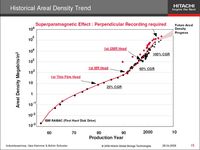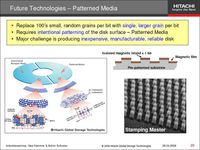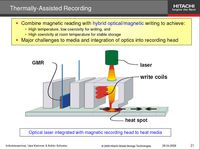A Look Into The Hard Drive's Future
Future Capacities and Recording Improvements
So where is the hard drive heading now? We took some slides that we received during a Hitachi GST technology seminar some months ago, to help us look into the future.
You can expect all major hard drive makers to work on the same or at least similar technologies, as capacity leadership is the key to the mainstream, and performance leadership is the key to opinion leaders and hence to a nice reputation. Manufacturers who provide the fastest drives will be discussed for a while, and makers delivering maximum performance per platter can offer the highest capacity single-platter drive for the mainstream. The latter is highly relevant for notebook system builders, and is typically considered the sweet spot.
Areal Density
Obviously, data density (measured in megabits per square inch or Mb/in²) is the key to increasing storage capacities. While the growth rate has been significant in recent years, perpendicular recording was necessary to overcome the so-called superparamagnetic effect, which causes magnetic elements to influence each other, compromising data safety. Perpendicular recording realigns the stored bits to be stored in a vertical fashion to solve this issue. All current hard drives are based on PMR technology, which was necessary to jump over the terabyte line for 3.5” drives and to reach 500 GB for 2.5” notebook drives. We’re currently looking at 250 Gbit/in² densities, and between the third and fifth generation of perpendicular recording technology, depending on the manufacturer and drive family. PMR alone allowed for an increase in areal density of at least 100%.
Up to 50 TB for 3.5” Drives and 12 TB for 2.5” Drives
Hitachi says that, based on today’s knowledge, using optimized and improved perpendicular recording, densities can quadruple. A key for this improvement will be patterned media technology, which is expected to result in 2.5” notebook drives at 1.5 TB by the beginning of the next decade and roughly 4 TB by 2013. Desktop hard drives will have reached around 10 TB by then. The next step depends on the success and development speed of patterned media: thermally assisted recording would allow creating 10 to 12 TB 2.5” notebook hard drives, and allow squeezing up to 50 TB onto a 3.5” desktop hard drive. However, it will still take many years until we get anywhere close to that.
Patterned Media
Get Tom's Hardware's best news and in-depth reviews, straight to your inbox.
Patterned media is very much self-explanatory: it means that the platters will hold a preset structure, which defines the exact location for each bit. Think of it as an incredibly small honeycomb, which will be used to further reduce the superparamagnetism effect and hence make sure that stored bits don’t influence each other. Recording densities can then be increased without jeopardizing data integrity.
Hitachi says that one of its suppliers already offers patterned media platters, but it does not expect patterned media to reach the mainstream before 2010. It is, however, already developing this technology, and will consider a deployment once PMR hit its limits.
Thermally Assisted Recording
Although thermally assisted recording is still years away, hard drive vendors all agree that this will most likely be the next significant step, and will involve alternative materials for recording. Hitachi didn’t specify them, but storing magnetic information in a highly reliably manner will remain the most important issue.
Perpendicular recording changes the magnetic orientation to prevent individual bits from interfering with each other. Patterned media will introduce a structure that allows moving the bits closer to each other in order to increase recording density. Thermally assisted recording will utilize laser technology to increase material temperature in an effort to change its magnetic properties. Read operations will not require laser-powered heat, as the magnetization will be very stable, but precisely applied heat will be used to write information.
Current page: Future Capacities and Recording Improvements
Prev Page Market Opportunities Next Page More Features: Vibration Control, Height Adjustment


